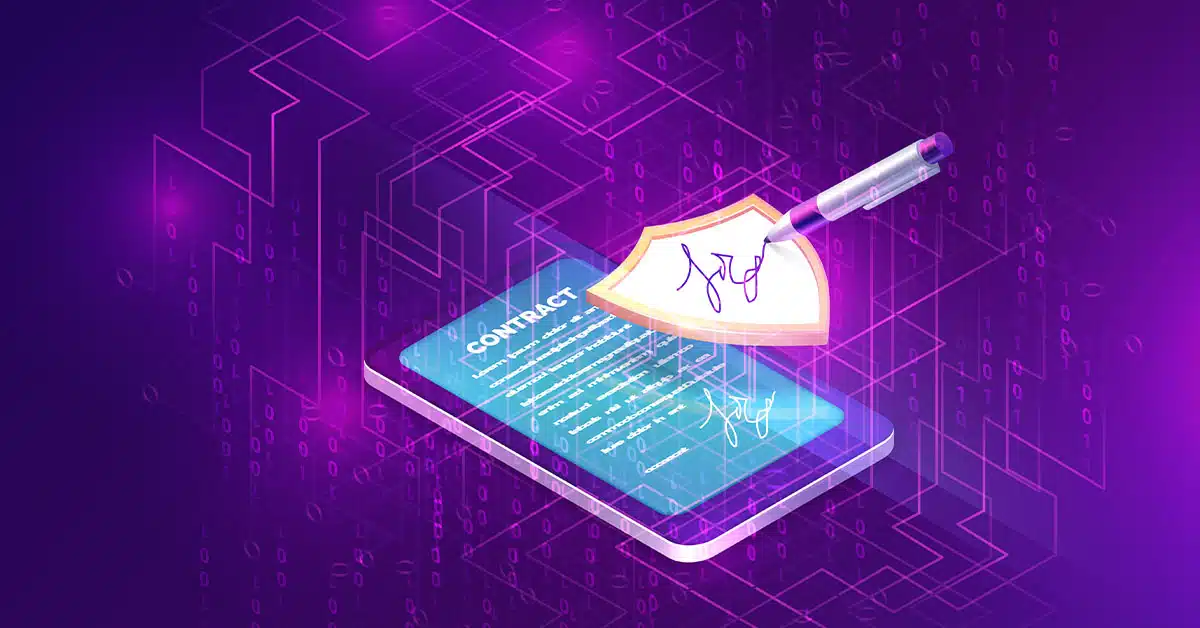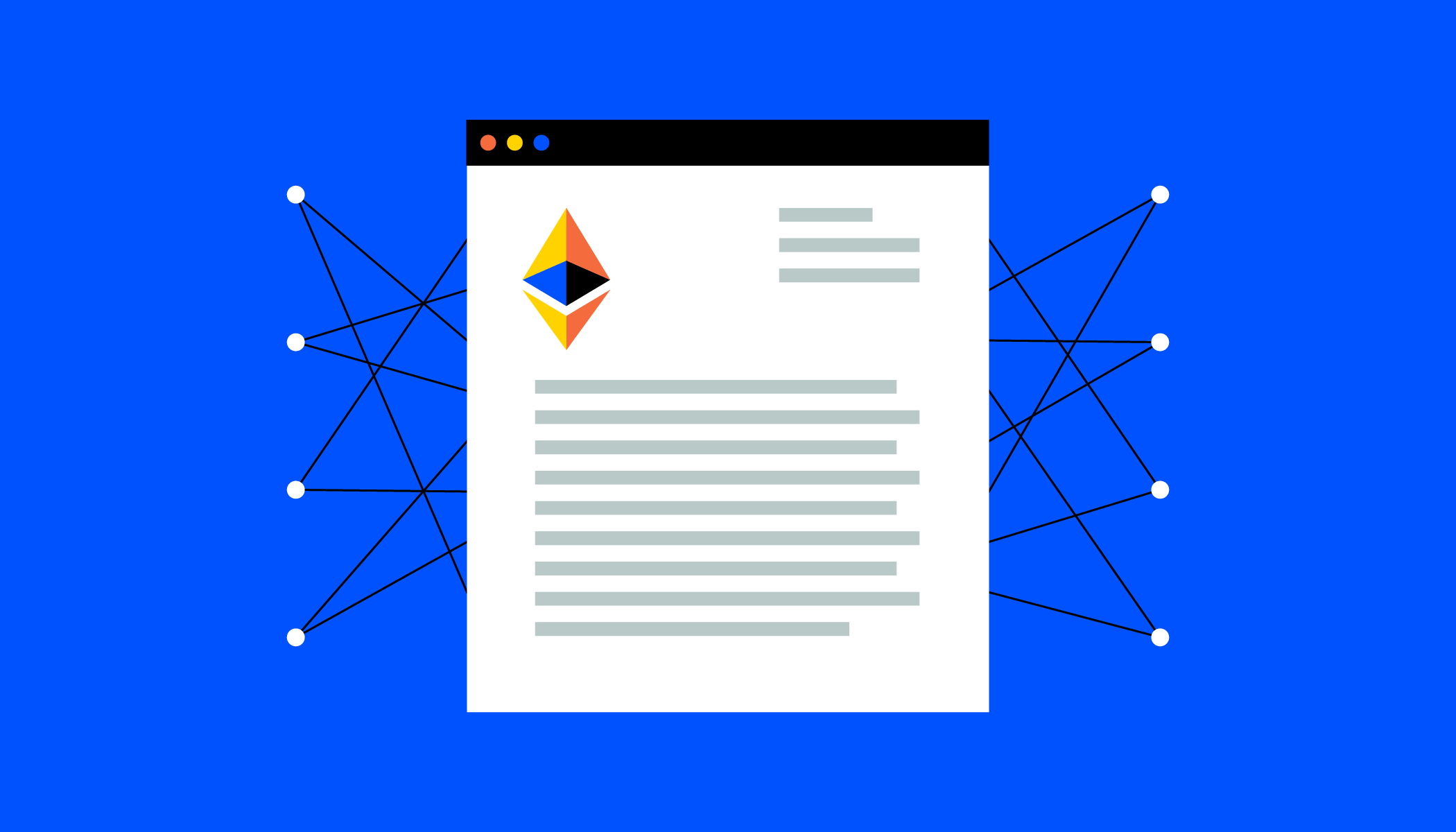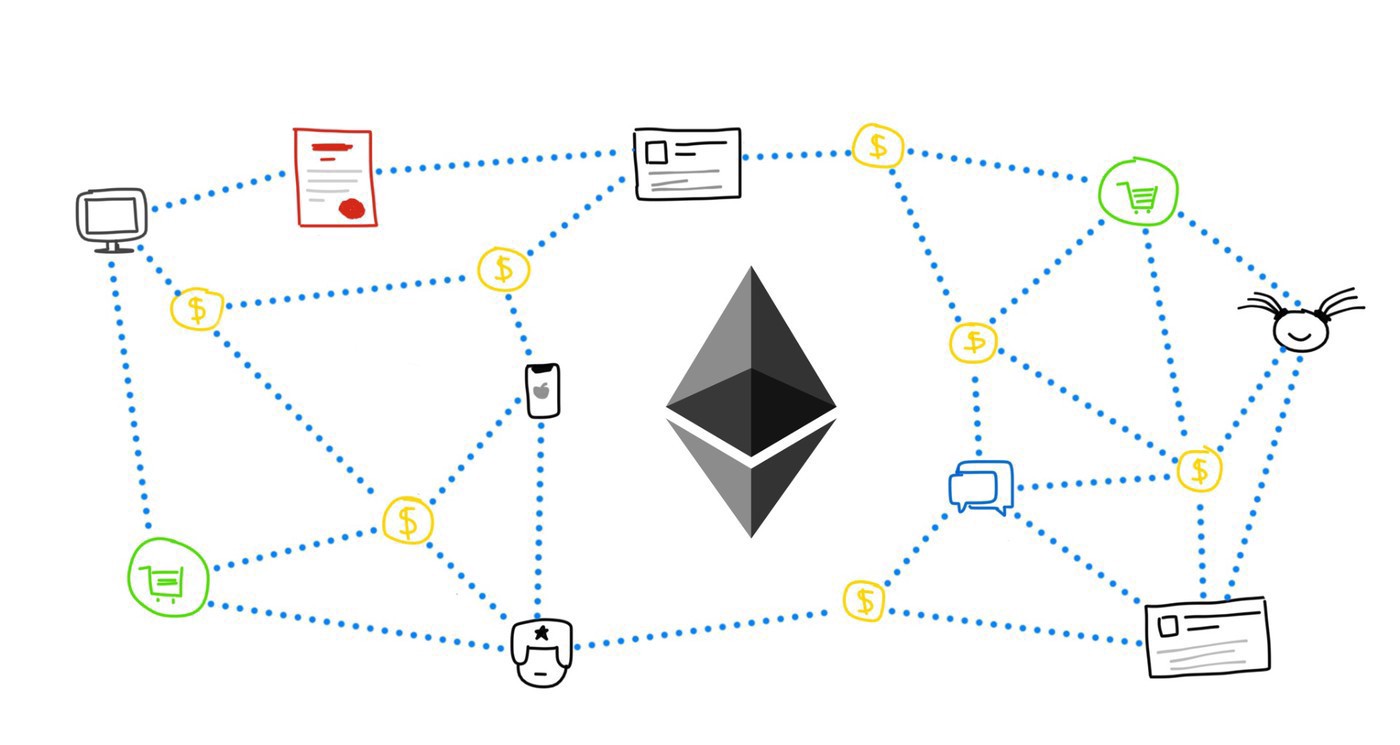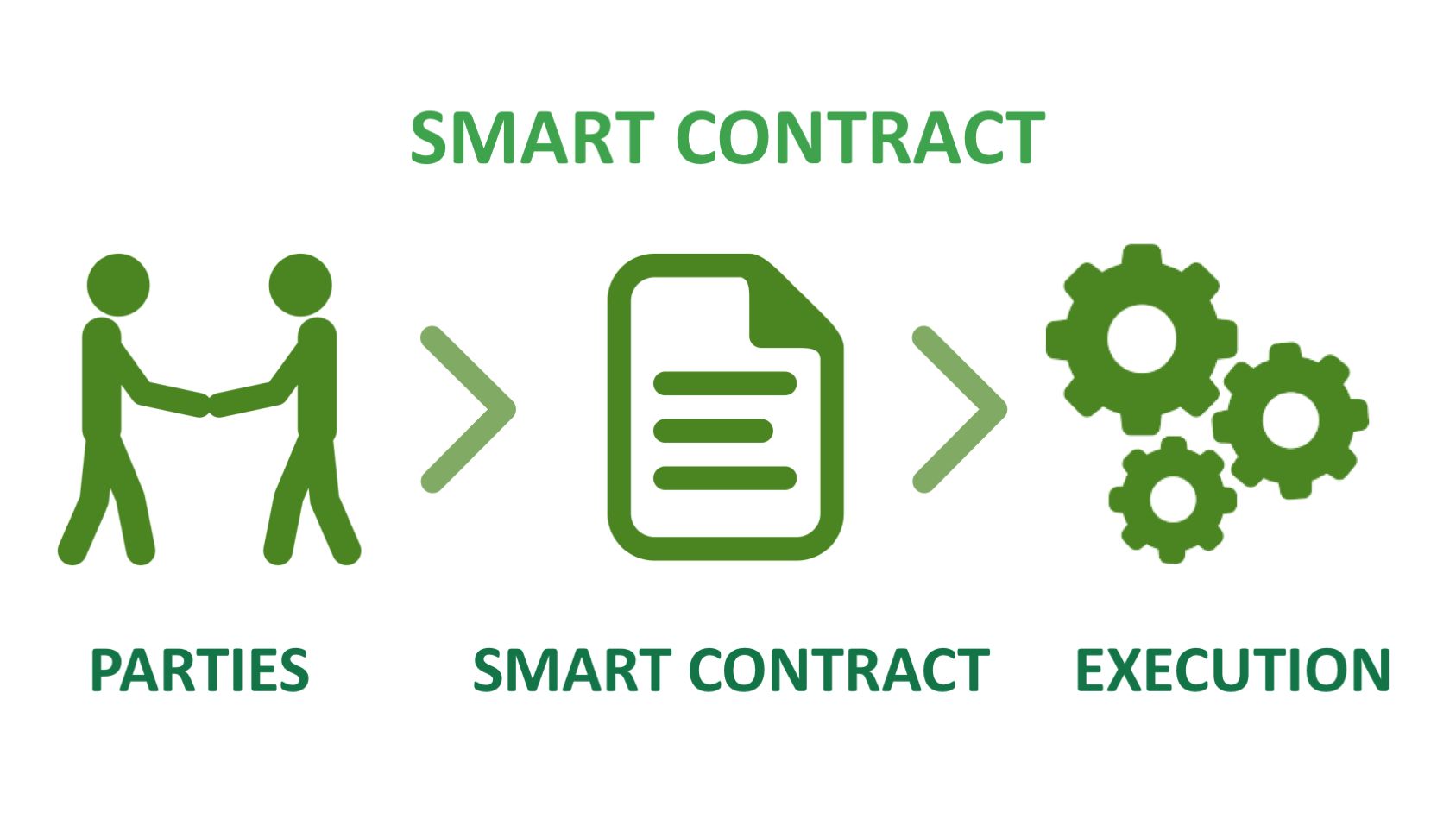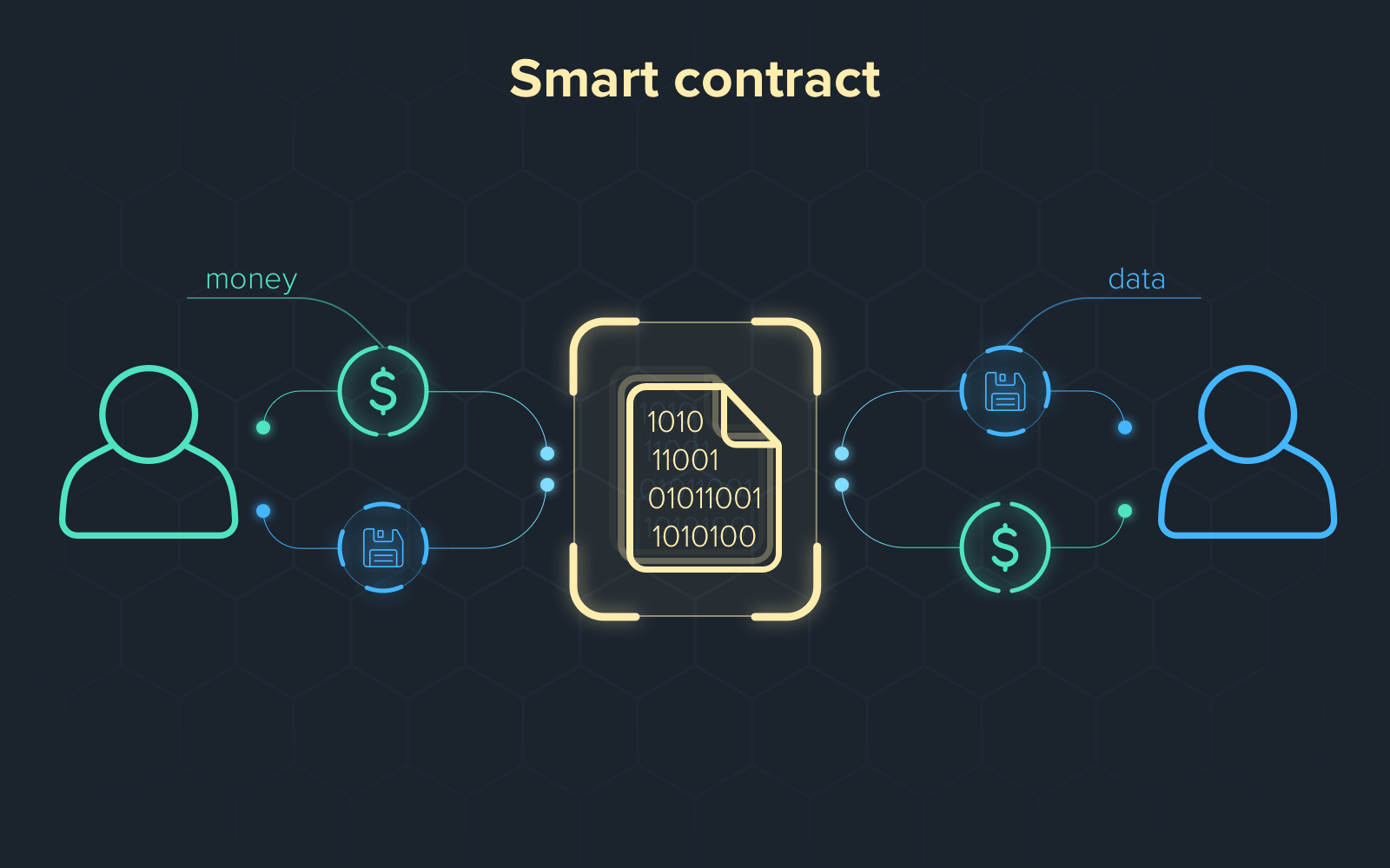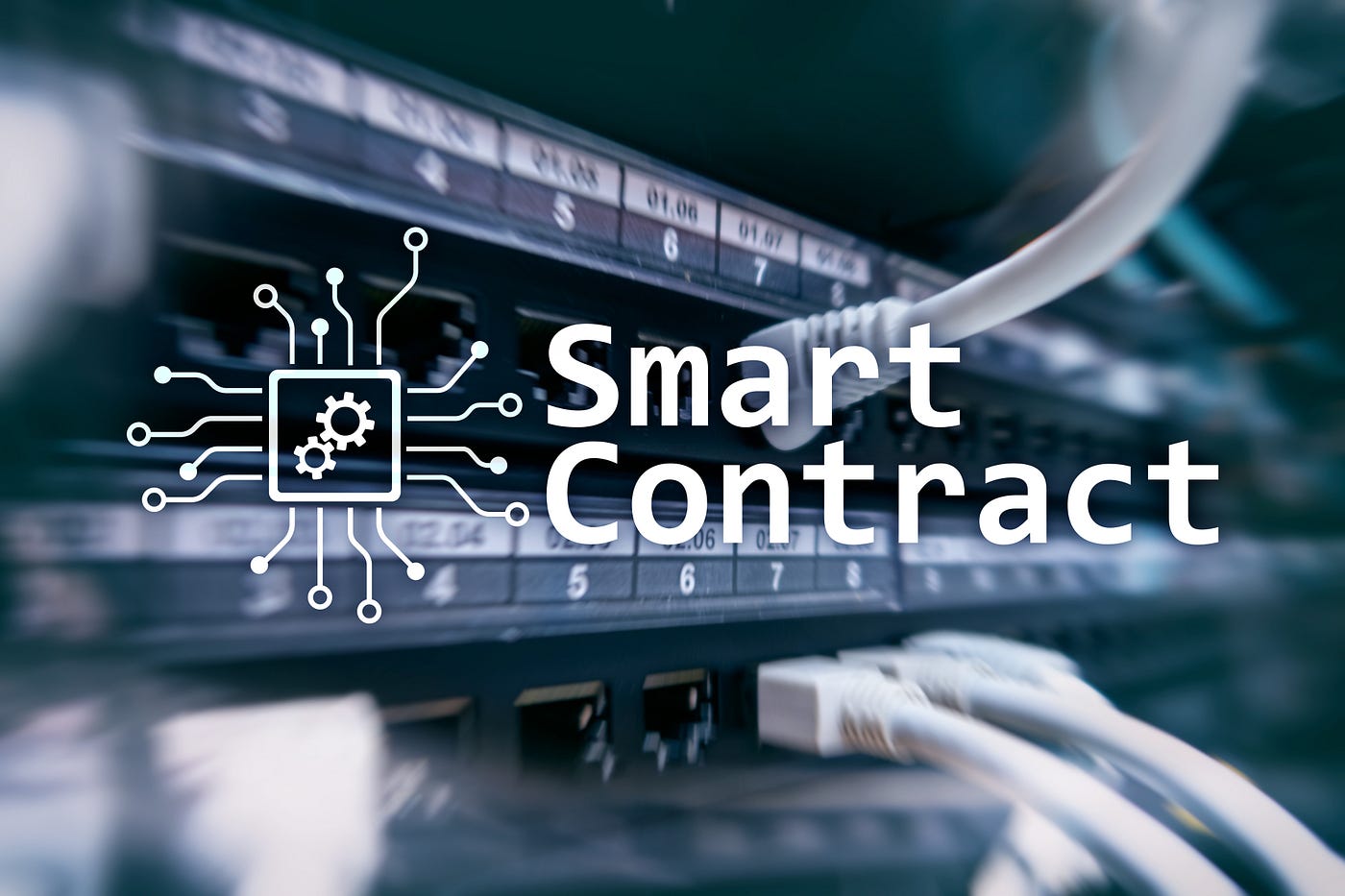Introduction
Welcome to the world of smart contracts! In this digital era, where advancements in technology continue to reshape various industries, smart contracts have emerged as a game-changer in the field of programming and business transactions. From finance to healthcare, supply chain management to real estate, smart contracts are revolutionizing the way agreements are made and executed.
Smart contracts utilize blockchain technology to create self-executing digital contracts. These contracts automatically enforce the terms and conditions agreed upon by the involved parties, without the need for intermediaries. This decentralized approach ensures transparency, security, and efficiency in the contract execution process.
With the increasing popularity of cryptocurrencies like Bitcoin and Ethereum, smart contracts have gained significant attention. They enable the automation of complex, multi-step processes, eliminating manual tasks and reducing the risk of human error. Additionally, smart contracts provide a level of trustworthiness and immutability through the use of cryptographic verification.
Understanding the benefits and principles of smart contracts requires a basic understanding of blockchain technology. Blockchain is a distributed ledger system that records and verifies transactions across multiple computers, making it highly resistant to tampering and fraud. To leverage smart contracts effectively, it is essential to have a grasp of the underlying blockchain technology that powers them.
This article serves as a comprehensive guide to developing smart contracts. Whether you are an aspiring blockchain developer or a business professional looking to implement smart contracts in your operations, this guide will provide you with the necessary knowledge and tools to get started. We will explore programming languages commonly used for smart contract development, setting up a development environment, writing, testing, and deploying smart contracts. Additionally, we will discuss best practices and security considerations to ensure the robustness and integrity of your smart contracts.
So, let’s dive into the world of smart contracts and unlock their potential to revolutionize the way we conduct business transactions!
What are Smart Contracts?
In simple terms, smart contracts are self-executing digital contracts that are represented and stored on a blockchain. Traditional contracts involve parties agreeing on terms and conditions, which are then enforced by intermediaries such as lawyers or banks. Smart contracts, on the other hand, eliminate the need for intermediaries by automatically executing contract terms when predefined conditions are met.
Smart contracts are built on blockchain technology, a decentralized and distributed ledger system. This ensures that the contract is transparent, secure, and tamper-proof. Once a smart contract is deployed on the blockchain, it becomes immutable, meaning that it cannot be altered or modified. This immutability adds an extra layer of trust and credibility to the contract.
The execution of a smart contract relies on the predefined rules and conditions written into the code. These rules are self-executing, meaning that the contract automatically executes itself when the conditions are met. For example, in a real estate smart contract, the contract could release funds to the seller once the buyer confirms receipt of the property title. This eliminates the need for manual intervention and ensures a smooth and efficient transaction process.
Smart contracts bring numerous benefits to the table. Firstly, they eliminate the need for intermediaries, reducing costs and eliminating the risk of human error. Transactions can be executed directly between parties, speeding up the process and saving time. Additionally, smart contracts offer transparency, as all contract terms and conditions are visible on the blockchain, accessible to all parties involved.
Another significant advantage of smart contracts is their potential for automation and efficiency. They enable the automation of complex business processes, eliminating the need for manual intervention at each step. This automation reduces the risk of errors and accelerates the execution of transactions.
It is essential to note that smart contracts are not limited to financial transactions. While they have gained traction primarily in the realm of cryptocurrency and finance, their applicability extends to various industries and sectors. Smart contracts can be utilized in supply chain management, healthcare, real estate, insurance, and more. Their flexibility and versatility make them suitable for a wide range of use cases.
In the next sections, we will explore the underlying technology behind smart contracts, programming languages used for their development, as well as the process of writing, testing, and deploying smart contracts. So, let’s continue our journey into the world of smart contracts and unlock their full potential!
Benefits of Smart Contracts
Smart contracts offer several compelling benefits, making them an attractive option for businesses and individuals looking to streamline and automate their contractual agreements. Let’s explore some of the key advantages:
1. Efficiency: One of the primary advantages of smart contracts is their ability to automate processes and eliminate manual intervention. By removing the need for intermediaries and relying on self-executing code, smart contracts significantly reduce the time and effort required to execute a contract. This increased efficiency translates into faster transactions and reduced costs.
2. Transparency: Smart contracts are built on blockchain technology, which provides a transparent and immutable ledger. All contract terms and conditions are stored and visible on the blockchain, accessible to all parties involved. This transparency enhances trust and accountability, as each party can verify the execution of the contract and ensure compliance.
3. Security: Smart contracts offer enhanced security compared to traditional contracts. The use of cryptography and the decentralized nature of blockchain technology make smart contracts highly resistant to tampering and fraud. Once a smart contract is deployed on the blockchain, it becomes immutable, ensuring that the terms and conditions cannot be altered without consensus from the involved parties.
4. Cost-Effective: Smart contracts eliminate the need for intermediaries, such as lawyers or banks, thereby reducing costs associated with their involvement. By automating the execution of the contract and removing the middlemen, businesses can save money on transaction fees and administrative expenses.
5. Accuracy: Traditional contracts are susceptible to human error, but smart contracts rely on predefined rules and conditions written into the code. This reduces the risk of errors and ensures accurate execution of the contract terms. Additionally, smart contracts can perform complex calculations and logic automatically, eliminating the need for manual calculations and reducing the likelihood of mistakes.
6. Speed: Smart contracts enable near-instantaneous execution of transactions. Traditional contracts often involve time-consuming processes, including manual reviews, negotiations, and paperwork. Smart contracts automate these steps and allow for instant verification and execution, accelerating the overall transaction process.
7. Scalability: With traditional contracts, scaling transactions and agreements across multiple parties can be challenging and time-consuming. Smart contracts provide a scalable solution by allowing for the automation of large-scale agreements involving multiple parties. This scalability reduces administrative overhead and ensures efficient execution even with a high volume of contracts.
These are just a few of the benefits that smart contracts bring to the table. As the technology continues to evolve and gain wider adoption, we can expect to see even more advantages emerging. Now that we understand the benefits of smart contracts, let’s delve into the underlying technology that powers them: blockchain.
Understanding Blockchain Technology
Before delving further into smart contracts, it’s crucial to have a solid understanding of the technology that underpins them: blockchain. Blockchain is a decentralized and distributed ledger system that maintains a continuously growing list of records, called blocks, linked together in a chain. Each block contains a timestamp, a unique identifier (hash), and a reference to the previous block, creating a chronological and tamper-proof record of transactions.
The decentralized nature of blockchain ensures that multiple copies of the ledger are stored across a network of computers, known as nodes. This network structure eliminates the need for a central authority or intermediary, as every participant in the network holds a copy of the entire blockchain. This distributed consensus model enhances security, transparency, and trust, as the ledger’s integrity relies on a majority consensus among the participating nodes.
The security of blockchain is mainly attributed to two factors: immutability and cryptographic verification. Once a block is added to the blockchain, it becomes virtually impossible to modify without the consensus of the participating nodes. Any attempt to tamper with a block in the chain will result in an invalid hash, alerting the network to the tampering attempt. Additionally, the use of cryptographic algorithms ensures that transactions recorded in the blockchain are secure and can be verified by participants in the network.
Blockchain technology has gained significant traction primarily due to its application in cryptocurrencies, such as Bitcoin and Ethereum. However, its potential extends well beyond the realm of digital currencies. Blockchain is being explored and implemented in various industries, including finance, supply chain management, healthcare, and more. Its ability to provide a transparent, secure, and decentralized platform for recording and verifying transactions makes it attractive for applications that require trust, efficiency, and immutability.
Blockchain technology plays a critical role in enabling the functionality of smart contracts. Smart contracts are stored and executed on a blockchain, taking advantage of its decentralized nature and security features. The blockchain ensures that the terms and conditions of the smart contract are transparently recorded, and once deployed, the contract’s execution is tamper-proof, providing a high level of trust and reliability.
Now that we have a solid understanding of blockchain technology and its relevance to smart contracts, let’s dive into the programming languages commonly used for smart contract development.
Programming Languages for Smart Contracts
When it comes to developing smart contracts, different blockchain platforms offer support for various programming languages. These languages serve as the building blocks for writing the code that defines the behavior and logic of smart contracts. Here are some of the commonly used programming languages for smart contract development:
1. Solidity: Solidity is the most popular and widely used programming language for developing smart contracts on the Ethereum blockchain. It is a statically-typed, high-level language with a syntax similar to JavaScript. Solidity allows developers to define the data structures, functions, and event triggers of a smart contract. It also supports inheritance, libraries, and low-level operations for interacting with the Ethereum Virtual Machine (EVM).
2. Vyper: Vyper is another programming language specifically designed for smart contracts on the Ethereum platform. Vyper aims to provide a more secure and auditable alternative to Solidity. It has a simplified syntax and restricts certain operations to minimize potential vulnerabilities. Vyper focuses on readability and encourages developers to write clear and concise code.
3. Scilla: Scilla is the programming language used for writing smart contracts on the Zilliqa blockchain platform. It is designed to address security concerns and enable formal verification of smart contracts. Scilla has a strong static type system and emphasizes clarity and correctness. It supports features like contract states, message passing, and libraries, making it suitable for building complex decentralized applications.
4. Cadence: Cadence is the main programming language for smart contracts on the Flow blockchain platform, developed by Dapper Labs. It is designed to enable secure and understandable smart contract development for non-expert programmers. Cadence emphasizes resource-oriented programming and enforces strict ownership and borrowing rules to prevent common pitfalls in blockchain smart contract development.
5. LIGO: LIGO is a high-level programming language specifically designed for smart contracts on the Tezos blockchain. It offers multiple syntaxes, including Pascal and ReasonML, to cater to developers with different coding preferences. LIGO focuses on formal verification and readability, allowing developers to write secure and efficient smart contracts.
Other blockchain platforms, such as NEO, EOS, and Cardano, have their own programming languages tailored for smart contract development. It’s important to choose a programming language that is well-supported by the target blockchain platform and aligns with your development goals and requirements.
By mastering one or more programming languages for smart contracts, you can unlock the ability to create decentralized applications and execute complex business logic in a transparent and secure manner. In our next section, we will explore how to set up a development environment for smart contract development. So, let’s proceed to the next step of our journey!
How to Set Up a Development Environment
Setting up a development environment is a crucial step in smart contract development. It involves installing the necessary tools and frameworks to write, test, and deploy smart contracts. Here’s a step-by-step guide on how to set up a development environment:
1. Choose the Blockchain Platform: The first step is to select the blockchain platform on which you will be developing smart contracts. Ethereum, for example, is a popular choice due to its wide adoption and robust ecosystem. Other platforms like Zilliqa, Tezos, and Flow also offer unique features and advantages. Choose the platform that best suits your project requirements.
2. Install a Code Editor: To write and edit smart contract code, you’ll need a code editor with support for the chosen programming language. Visual Studio Code, Atom, and Sublime Text are popular options that offer syntax highlighting, autocompletion, and other useful features for smart contract development.
3. Set Up a Blockchain Wallet: In order to deploy and interact with smart contracts on a blockchain, you’ll need a blockchain wallet. This wallet will serve as your digital identity and provide the necessary cryptographic keys to sign transactions. MetaMask is a popular wallet extension for Ethereum, while other blockchains have their own wallet solutions.
4. Install the Blockchain Development Framework: The next step is to install the development framework specific to the chosen blockchain platform. For Ethereum, the Truffle Suite is a widely used framework that provides a comprehensive set of tools for smart contract development, testing, and deployment. Other platforms have their own development frameworks, so make sure to choose the one corresponding to your selected platform.
5. Set Up a Local Blockchain Development Network: To test and debug smart contracts, it’s recommended to set up a local blockchain development network. Ganache is a popular tool that provides a local Ethereum blockchain network for development purposes. It allows you to simulate transactions and interactions with smart contracts in a controlled environment.
6. Learn and Explore the Development Tools: Take time to familiarize yourself with the development tools provided by the chosen blockchain platform. These tools include compilers, deployment scripts, testing frameworks, and debugging tools. Understanding how to use these tools effectively will streamline your development workflow and help ensure the quality and reliability of your smart contracts.
7. Join the Developer Community: Engage with the developer community around the blockchain platform you’ve chosen. Participate in forums, discussion groups, and online communities to learn from others, ask questions, and seek guidance. Collaboration and knowledge-sharing within the community can greatly contribute to your growth as a smart contract developer.
By following these steps, you will have a well-equipped development environment to start developing smart contracts. Remember to regularly update your development tools and stay up-to-date with the latest advancements and best practices in smart contract development. In our next section, we will dive into the process of writing smart contracts. Let’s continue our journey into the world of smart contracts!
Writing Smart Contracts
Once you have set up your development environment, you’re ready to start writing smart contracts. Writing a smart contract involves defining the contract’s structure, specifying its functions and variables, and implementing the desired behavior using the programming language of your chosen blockchain platform. Here’s a step-by-step guide on how to write smart contracts:
1. Define the Contract Structure: Begin by defining the structure of the smart contract. This includes identifying the variables, functions, and events that will be included in the contract. Think about the purpose and requirements of the contract and how it interacts with other contracts or external entities.
2. Specify Functions and Variables: For each function, specify the inputs, outputs, and any required modifiers or access controls. Define the variables that will hold the contract’s state and any additional variables needed for calculations or storage.
3. Implement the Functionality: Write the code to implement the desired functionality of the smart contract. This may include calculations, data manipulation, and external interactions. Ensure that the code accurately reflects the intended behavior of the contract and handles exceptions or edge cases appropriately.
4. Handle Events and Logging: Consider using events and logging to provide transparency and allow external entities to track important contract events. Emit events at significant points in the contract’s execution to notify listeners and enable them to react accordingly.
5. Ensure Security and Error Handling: Pay close attention to security considerations and implement necessary security measures to protect the contract and its users. Enforce proper access controls, input validation, and handle potential vulnerabilities such as reentrancy attacks or integer overflow/underflow. Include appropriate error handling mechanisms to ensure graceful handling of exceptions and edge cases.
6. Test Thoroughly: It’s crucial to thoroughly test your smart contracts to ensure they function as intended. Write unit tests and scenario-based tests to cover various aspects of the contract’s functionality. Test edge cases, input validations, and different execution scenarios using testing frameworks provided by the development tools.
7. Document and Comment: Document your smart contract code thoroughly to provide clarity and aid future maintainability. Add comments to explain complex logic, document input/output expectations, and provide any other relevant information. Good documentation will make it easier for other developers to understand and collaborate on your code.
8. Follow Best Practices: Adhere to best practices specific to the programming language and platform you are using. Follow naming conventions, code formatting guidelines, and architectural patterns recommended by the development community. Consider utilizing design patterns such as the Factory pattern or the State Machine pattern to improve the structure and maintainability of your smart contracts.
By following these steps, you can develop smart contracts that are secure, reliable, and perform as intended. Regularly review and update your contracts as needed, considering feedback from users, security audits, and improvements in industry best practices. In our next section, we will explore the process of testing and debugging smart contracts. Let’s continue our journey into the world of smart contracts!
Testing and Debugging Smart Contracts
Testing and debugging are critical steps in smart contract development to ensure that the contract functions correctly, handles edge cases appropriately, and is secure from vulnerabilities. Proper testing and debugging practices can help you identify and resolve issues before deploying your smart contracts. Here are some guidelines for testing and debugging smart contracts:
1. Writing Unit Tests: Develop unit tests to verify the functionality of individual functions within your smart contract. Use testing frameworks provided by your chosen blockchain platform, such as Truffle for Ethereum, to create automated tests. Test various scenarios, including different input values, boundary cases, and corner cases to provide comprehensive coverage.
2. Creating Scenario-Based Tests: Beyond unit tests, devise scenario-based tests to simulate real-world interactions and complex use cases. These tests should cover different contract states, interactions between multiple contracts, and various user roles. Evaluate the outcomes of these tests to ensure the contract behaves as expected in different scenarios.
3. Emulate Test Networks: Use local development networks or test networks provided by the blockchain platform to test your smart contracts. For Ethereum, tools like Ganache provide local blockchain networks that replicate the behavior of the main network, allowing you to test your contracts in a controlled environment without incurring actual transaction costs.
4. Conduct Security Audits: Perform security audits or use security analysis tools to identify potential vulnerabilities or weaknesses in your smart contracts. Verify that the contract follows best practices to avoid known security pitfalls, such as reentrancy attacks, integer overflow/underflow, or improper access controls. Implement appropriate countermeasures to mitigate these vulnerabilities.
5. Test Gas Consumption: Evaluate the gas consumption of your smart contract to ensure that it operates within the intended limits. Gas is a measure of computational effort in the Ethereum network, and each transaction consumes a certain amount of gas. Optimize your contract’s code, data storage, and execution flow to minimize gas costs and improve efficiency.
6. Debugging Tools: Utilize the debugging tools provided by your development framework. Truffle, for example, offers a built-in debugger that allows you to step through your contract’s execution and inspect variable values at each step, helping identify and resolve issues in your code.
7. Testnet Deployment: When you’re confident in the functionality and security of your smart contract, deploy it onto a testnet. Testnet deployments enable you to interact with your contract in a realistic environment, testing real transactions and interactions. This provides valuable feedback on the contract’s performance and user experience.
8. Iterative Testing and Refactoring: Continuously test, review, and improve your smart contracts iteratively. Incorporate user feedback, monitor contract performance, and respond to emerging issues promptly. Regularly update and refactor your smart contracts to maintain their security and optimize their efficiency.
Testing and debugging are ongoing efforts throughout the development lifecycle of smart contracts. By following these best practices and conducting thorough testing, you can ensure your smart contracts are robust, secure, and reliable. In our next section, we will explore the process of deploying smart contracts. Let’s continue our journey into the world of smart contracts!
Deploying Smart Contracts
After testing and debugging your smart contracts, the next step is to deploy them onto the blockchain. Deploying a smart contract involves deploying the contract’s bytecode and creating an instance of the contract on the targeted blockchain platform. Here are the key steps to deploy smart contracts:
1. Select the Deployment Network: Choose the network on which you want to deploy your smart contract. This can be the mainnet (production network) or a testnet (a network specifically designed for testing purposes). Deploying on a testnet allows you to assess the behavior and functionality of your contract without incurring any real transactions cost.
2. Prepare Deployment Artifacts: Compile your smart contract code into bytecode and create the necessary deployment artifacts. The deployment artifacts typically consist of the bytecode, the contract’s Application Binary Interface (ABI), and any necessary constructor initialization parameters. These artifacts will be needed to deploy and interact with the contract.
3. Configure Deployment Parameters: Set up the necessary deployment parameters, such as the gas limit and gas price. Gas limit is the maximum amount of gas that can be used for the deployment transaction, while gas price determines the amount you are willing to pay for each unit of gas consumed.
4. Connect to the Blockchain Network: Establish a connection to the target blockchain network using tools like Metamask, the command line interface (CLI) of the blockchain platform, or development frameworks like Truffle. This connection allows you to interact with the network and deploy your smart contract.
5. Deploy the Smart Contract: Initiate the deployment process by sending a deployment transaction to the network. This transaction includes the bytecode and deployment artifacts of the smart contract. Wait for the transaction to be confirmed and mined into a block on the blockchain. Once confirmed, the contract is deployed, and you receive the contract address, which serves as the unique identifier of your smart contract on the blockchain.
6. Interact with the Deployed Contract: After deployment, you can interact with the deployed smart contract using the contract address and the ABI. Use your chosen development tools or frameworks to create transactions that call the functions defined in the smart contract. These transactions can read or modify the state of the contract and trigger the execution of the contract’s logic.
7. Monitor and Upgrade: Continuously monitor the behavior and performance of your deployed smart contracts. Keep track of events emitted by the contract, monitor gas usage, and gather feedback from users and stakeholders. If necessary, you can upgrade the contract by deploying a new version and migrating the data and interactions from the old contract to the new one.
Deploying smart contracts requires careful planning and consideration of network configurations, deployment parameters, and interactions with the target blockchain. By following these steps and utilizing the available tools, you can successfully deploy your smart contracts and make them available for use on the blockchain. In our next section, we will discuss how to interact with smart contracts. Let’s continue our exploration of the world of smart contracts!
Interacting with Smart Contracts
Once your smart contracts are deployed on the blockchain, you can interact with them to execute their functions, read their state, and participate in their workflow. Interacting with smart contracts involves sending transactions to the contract’s address and invoking its functions. Here’s a guide on how to interact with smart contracts:
1. Connect to the Blockchain: Connect your application or development environment to the desired blockchain network using tools like Metamask or development frameworks like Web3.js for Ethereum. This connection enables your application to interact with the blockchain and communicate with deployed smart contracts.
2. Obtain the Contract Address and ABI: Get the contract address and the Application Binary Interface (ABI) of the deployed smart contract. The contract address serves as the identifier for the specific contract instance on the blockchain, while the ABI provides the contract’s interface with its functions, variables, and event signatures.
3. Load the Contract: Load the contract into your application or development environment using the contract address and ABI. This step establishes a connection between your application and the deployed contract, allowing you to interact with its functions and retrieve its state.
4. Execute Contract Functions: Invoke the functions defined in the contract to perform actions and modify the contract’s state. Call the functions with the required parameters, and if necessary, specify the gas limit and gas price for the transaction. The blockchain network will execute the function as a transaction, updating the contract’s state accordingly.
5. Read Contract State: Retrieve the current state of the contract by accessing its variables and functions marked as constant or view. These functions do not modify the contract’s state and can be called without sending a transaction. By reading the contract state, you can obtain information stored within the contract without incurring transaction costs.
6. Listen for Contract Events: Subscribe to contract events emitted by the deployed smart contract. Events provide a way for smart contracts to communicate and notify external entities about specific occurrences. By registering event listeners, you can automatically capture and react to these events in your application.
7. Handle Transaction Receipts: After invoking contract functions, you receive a transaction receipt that contains information about the executed transaction, including the transaction hash, gas used, and status. You can use this receipt to track the success or failure of the transaction and handle any necessary error handling or response logic in your application.
8. Security Considerations: When interacting with smart contracts, pay attention to security measures such as input validation, access controls, and protection against reentrancy attacks. Ensure that proper user authentication, authorization, and input sanitization are in place to prevent unauthorized access or manipulation of the contract’s functions and state.
Interacting with smart contracts empowers your application to leverage the functionalities and benefits provided by decentralized systems. By following these guidelines, you can seamlessly integrate smart contracts into your application and participate in decentralized workflows. In our next section, we will discuss the best practices for smart contract development. Let’s continue our exploration of the world of smart contracts!
Best Practices for Smart Contract Development
Developing robust and secure smart contracts requires adherence to best practices that ensure reliability, security, and efficiency. By following these best practices, you can reduce the risk of vulnerabilities and ensure the proper functioning of your smart contracts. Here are some key best practices for smart contract development:
1. Security Audits: Conduct security audits of your smart contracts to identify potential vulnerabilities or weaknesses. Engage professional auditors or utilize automated security analysis tools to identify common pitfalls and ensure the security of your contracts.
2. Code Reusability: Utilize code reusability by breaking down your smart contract functionalities into modular components. This approach allows for easier maintenance, reduces code duplication, and promotes code readability.
3. Favor Readability over Optimization: Emphasize code readability and clarity over premature optimization. While optimizing gas costs is essential, prioritizing readability ensures that your code is understandable and maintainable by yourself and others in the future.
4. Input Validation and Access Controls: Implement robust input validation to ensure that only valid and expected values are accepted as inputs to your functions. Additionally, enforce access controls to restrict sensitive functions only to authorized users or contracts.
5. Avoid Ether Errors: Pay attention to Ether errors such as incorrect handling of units (wei, ether) or improper conversion between different units. These errors can lead to accidental loss of funds or incorrect calculations.
6. Use Safe Math Libraries: Employ safe math libraries to prevent integer overflows or underflows, which can lead to vulnerabilities. These libraries provide arithmetic methods that handle overflow and underflow scenarios to ensure calculations are performed safely.
7. Avoid External Calls in Loop: Minimize or eliminate external calls within loops, as each external call consumes additional gas. Excessive external calls within loops can lead to high gas costs and potential performance issues.
8. Keep Contracts Simple: Strive for simplicity in your smart contracts. Complex and convoluted code can introduce unnecessary complexity and increase the risk of bugs or errors. Keep your contracts concise, separated into logical modules, and easy to understand.
9. Regular Code Reviews: Engage in regular code reviews with peers or experts in smart contract development. Code reviews help identify potential issues or areas of improvement, ensuring code quality and adherence to best practices.
10. Document Code and Processes: Document your smart contract code thoroughly, including inline comments and high-level documentation. Describe the contract’s functions, inputs, and outputs, as well as any relevant processes, to provide clarity and guidance to future developers and contract users.
By adopting these best practices, you can enhance the security, reliability, and maintainability of your smart contracts. Regularly update and educate yourself on emerging best practices and security considerations to stay up-to-date in the ever-evolving world of smart contract development. In our next section, we will explore security considerations specifically related to smart contract development. Let’s continue our journey into the world of smart contracts!
Security Considerations
When developing smart contracts, it is crucial to prioritize security to protect the integrity of the contract, user funds, and the overall blockchain ecosystem. Here are key security considerations to keep in mind during smart contract development:
1. Secure Authentication and Authorization: Implement robust authentication and authorization mechanisms to ensure that only authorized users or contracts can access sensitive functions and modify the contract’s state. Use cryptographic techniques, such as digital signatures, to verify the identity of participants.
2. Input Validation: Validate all input parameters to prevent invalid or malicious values from compromising the contract’s execution. Sanitize and validate user input to mitigate risks such as reentrancy attacks, integer overflow/underflow, or denial-of-service attacks.
3. Reentrancy Attacks: Guard against reentrancy attacks, where malicious contracts repeatedly call back into your contract during an ongoing transaction. Use the “checks-effects-interactions” pattern, in which you change the contract state before making external calls, to prevent reentrancy vulnerabilities.
4. Gas Limit and Out-of-Gas Situations: Be mindful of gas limits when executing complex or computationally expensive functions within your smart contract. Limit the potential for out-of-gas situations by ensuring gas consumption is appropriately estimated and managing gas usage efficiently.
5. Integer Overflow/Underflow: Protect against integer overflow and underflow vulnerabilities that can occur during arithmetic operations. Use safe math libraries or check for constraints such as maximum and minimum values to prevent unexpected behavior or potential exploitation.
6. Access Control: Clearly define and enforce access controls within your smart contracts to prevent unauthorized actions. Limit the execution of critical functions to specific roles or accounts and differentiate between user privileges to maintain the integrity of the contract.
7. External Dependencies: Be cautious when using external contracts or libraries, as they can introduce security risks. Thoroughly review and audit third-party contracts for potential vulnerabilities. When interacting with external contracts, validate their integrity and reliability to prevent unintended security breaches.
8. Oracle and External Data: When relying on external data feeds or oracles, ensure their trustworthiness and implement mechanisms to verify and validate the received data. Malicious or inaccurate external data can compromise the integrity and security of your smart contract’s logic and decisions.
9. Regular Security Audits: Engage in regular security audits conducted by external experts to identify vulnerabilities, assess the overall solidity of the contract, and ensure compliance with security best practices. Maintaining awareness and staying updated on emerging security threats is essential to address potential security vulnerabilities.
10. Continuous Monitoring and Incident Response: Regularly monitor your deployed contracts for any suspicious activities or vulnerabilities. Establish an incident response plan to handle and mitigate potential security breaches or exploits promptly. Detecting and responding to security incidents in a timely manner can minimize damage and protect user assets.
By adhering to these security considerations, you can minimize the risk of security breaches, protect user funds, and maintain the trust and integrity of your smart contract ecosystem. Remember that security is an ongoing effort, and staying vigilant is essential to safeguard your smart contracts throughout their lifecycle. In our next section, we will showcase examples of real-world smart contracts. Let’s continue our exploration into the world of smart contracts!
Examples of Smart Contracts
Smart contracts have found application in various industries, revolutionizing traditional processes and enabling new possibilities. Here are a few examples of real-world use cases where smart contracts have been implemented:
1. Decentralized Finance (DeFi): DeFi has emerged as one of the most prominent use cases for smart contracts. Platforms like Compound and Aave utilize smart contracts to create decentralized lending and borrowing protocols. These protocols allow users to lend their digital assets and earn interest while borrowers can access loans without relying on traditional financial intermediaries.
2. Supply Chain Management: Smart contracts are transforming supply chain management by bringing transparency and traceability to the process. Projects like VeChain and IBM’s Food Trust utilize smart contracts to track and verify the origin, quality, and movement of goods. This improves efficiency, reduces fraud, and enhances consumer trust by providing real-time visibility into the supply chain.
3. Real Estate Transactions: Smart contracts are streamlining real estate transactions by automating the process of buying, selling, and transferring property ownership. Platforms like Propy and Atlant leverage smart contracts to handle escrow, transfer property titles, and execute transactions securely and efficiently, reducing the need for intermediaries and reducing costs.
4. Tokenization of Assets: Smart contracts enable the tokenization of various assets, such as artwork, real estate, and intellectual property. Projects like Maecenas and Harbor use smart contracts to represent these assets as digital tokens on the blockchain. These tokens can be easily divided, traded, and fractionalized, unlocking liquidity and democratizing investment opportunities.
5. Insurance Claims: Smart contracts are transforming the insurance industry by automating claims processing and payouts. InsurETH, for example, utilizes smart contracts to manage flight delay insurance, automatically triggering claims and disbursing payments when flight delays meet predefined conditions. This reduces paperwork, eliminates delays, and enhances the efficiency and accuracy of insurance claim settlements.
6. Voting Systems: Smart contracts can be utilized to create tamper-proof and transparent voting systems. Platforms like Democracy Earth Foundation and Follow My Vote have pioneered the use of smart contracts to ensure secure and verifiable voting, preventing tampering and enhancing trust in the electoral process.
These are just a few examples of how smart contracts are reshaping various industries. As the technology continues to evolve, we can expect even more innovative applications leveraging the power of smart contracts. The versatility and potential of smart contracts are virtually limitless, and they continue to redefine how agreements and transactions are executed across a wide range of sectors.
In our final section, we will recap the key learnings and the importance of embracing smart contracts in today’s digital landscape. Let’s conclude our journey into the world of smart contracts!
Conclusion
Smart contracts have emerged as a powerful technology that revolutionizes the way agreements are made, executed, and enforced. By leveraging blockchain technology, smart contracts eliminate the need for intermediaries, enhance transparency, and improve the efficiency and security of transactions across various industries.
In this comprehensive guide, we have explored the fundamentals of smart contracts, the underlying blockchain technology, and the programming languages commonly used for their development. We have discussed the process of setting up a development environment, writing, testing, and deploying smart contracts. Additionally, we have highlighted best practices for smart contract development and emphasized the importance of security considerations.
Throughout our journey, we have seen how smart contracts are being utilized in real-world scenarios. From decentralized finance and supply chain management to real estate transactions and insurance claims, smart contracts are transforming industries, offering increased efficiency, transparency, and trust. These real-world examples demonstrate the potential of smart contracts to disrupt traditional systems and unlock new possibilities.
As the adoption of smart contracts continues to grow, it is essential for developers and businesses to embrace this technology. By leveraging the benefits of smart contracts, organizations can streamline processes, reduce costs, mitigate risks, and improve overall operational efficiency. However, it is crucial to remain mindful of security considerations, conduct regular audits, and stay updated on emerging best practices to ensure the integrity and reliability of smart contracts.
By embarking on this journey into the world of smart contracts, you have gained a solid foundation and understanding of their potential. As smart contract technology evolves and new applications emerge, continue to explore, learn, and innovate in this exciting field.
Embrace the power of smart contracts and unlock the possibilities they offer to shape a decentralized and efficient future.







